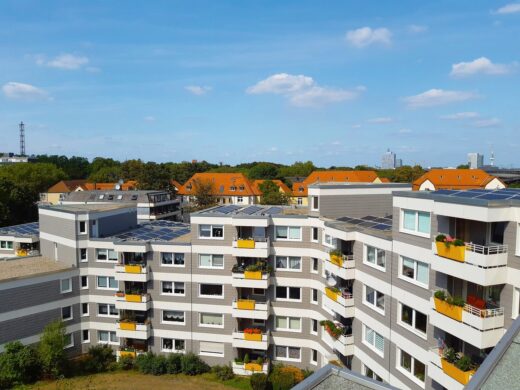Office architecture and design trends, Commercial real estate advice, Workplace property style
Which 4 trends are currently prevailing in Office Architecture & Design?
13 Jan 2023
In recent decades, the way, where and what we work has changed fundamentally. With the structural change, we turned into a service-oriented society with a vastly different approach to work compared to previous generations. In the wake of the global pandemic, current developments have been further expedited, which in turn influences our everyday working lives.
Thus, the demands we place on our workplace continue to change. To meet those demands, offices need to evolve with society and develop and implement innovative approaches. In this article, we observe these developments and present the four most current trends in office architecture & design.
Office Architecture & Design undergoes constant change guide
The term office architecture & design describes a fusion of art and technology that aspires to transform the offices in which we work. When designing the office of the future, it becomes crucial to keep up-to-date with the latest developments in order to be able to build offices that meet the needs of today’s world. Factors from different spheres of the environment have to be taken into account, especially from the technical, economic, ecological and social levels.
What are the latest technical achievements, and how can they optimise everyday working life? How can productivity be increased? How is economic growth possible if it is not to take place at the expense of our planet? What are society’s demands on a modern workplace? The answers to these questions, and thus also modern office architecture & design, change with time. Like all artistic and technical fields, office architecture & design finds itself in a constant state of transition.
These 4 trends will shape the office of the future
Undoubtedly, the single most significant impact on the way we work in recent years has been the global pandemic. However, COVID itself did not really create any new trends, but mainly accelerated existing trends and brought down outdated office structures sooner. Yet not all current trends can be attributed to the pandemic, as our breakdown will show.
If you are an architect or an interior designer creating offices these days, then you will be well aware of how imperative it is to keep up to date with the latest trends. While an architect or designer must find their own style, they must never reach a point where they close themselves off to new things and stop learning. In such a rapidly changing environment as today, one cannot afford not to keep up with the flow of time.
Below we present 4 current trends in the field of office architecture & design.
Multi-purpose use
Flexible designs that allow for different uses are becoming more and more popular in office architecture & design. Much of this has to do with the fact that today’s generation sees working in a completely different way than our parents’ or grandparents’ generation did. In the past, office work was characterised by cubicles in open-plan offices.
Today, however, office work tends to be much less repetitive and may also be performed from home. This has changed the purpose of the office to a place where people go to experience the corporate culture, to participate in creative exchange, and to be part of the company. A modern office should therefore be designed in such a way that it focuses not only on the actual manual work, but also on creative exchange and human interaction.
Sustainability
Man-made climate change is one of the biggest, if not the biggest, challenges of the 21st century. There is only one planet, and we must protect it before it is too late. One of the ways to do this is to put all our efforts into achieving the Paris climate goals. Office architecture & design faces a double challenge here. On the one hand, offices must be planned in such a way that they can be built in a sustainable and environmentally friendly manner.
On the other hand, offices also require sustainable operation. Good insulation, energy-saving building services etc. are part of the basic equipment range. However, an environmentally friendly use of an office also includes that the employees are affirmed in an environmentally friendly lifestyle. Thus, for example, the company location should be easily accessible by public transport, there should be enough bicycle parking spaces and sustainable consumption of resources must be a priority.
Technology
Digital technologies have become an integral part of today’s office life. However, digitalisation is also not a rigid reality, but a science in motion. At a time where many individuals work from home and where the internet has taken over so many things in our daily lives, we need to be receptive to and embrace new technologies. Digital technologies bring the potential to further facilitate our everyday working lives, to connect ideas and creativity, and to manage teams around the world. Therefore, technology must be a central element in the office architecture & design of the future. This includes, for example, virtual reality, smart offices and much more. The possibilities of the digital world are almost limitless.
Back to nature
Since the beginning of the industrial revolution in 18th and 19th century Europe, the centre of our work has moved more and more away from nature. The hunter-gatherer first became a farmer, then a specialised craftsman, then a factory worker and today an employee in a service society. In the everyday life of most people who live and work in urban areas, nature no longer has much of a place.
Biophilic interior design aims to change this. Biophilic interior design describes a trend in the architecture and design of homes and offices. Here, elements such as daylight, natural materials and planting are used in a way that brings nature into our interiors. This can help to reduce stress, work in a more concentrated way and achieve an inner balance. Biophilic interior design is one of the biggest trends in modern office architecture & design.
Trends in Office Architecture & Design: Conclusion
Office architecture & design is constantly changing. With the evolving influences from the social, economic, environmental and technological spheres, office architecture & design must constantly adapt. Many trends have been accelerated by the pandemic and are already evident to a strong degree, including the use of innovative technologies for networking or multi-purpose use.
Other trends, such as biophilic interior design or the urgency of a more environmentally friendly work society, were already developing in the way they are today. The fact is that professionals in office architecture & design have to move with the times if they want to continue to achieve first-class results in the future.
Comments on this guide to Which 4 trends are currently prevailing in Office Architecture & Design? article are welcome.
Offices Articles
Offices Posts
How to transform your office to make it comfortable
Simple ways to reduce distractions open-plan offices
Improving Office Wellbeing and Health
How to avoid wrong choices in real estate investing

Architects and Architecture
Architects and Architecture by Type – architectural selection below:
Comments / photos for the Office architecture and design trends guide page welcome






